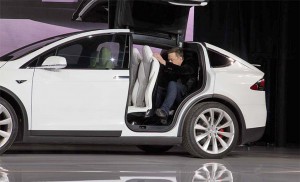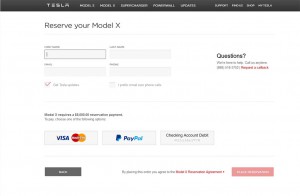Tesla’s new Model X battery-electric SUV will carry a starting price of $80,000 – before adding delivery charges and subtracting the $7,500 federal tax credit.
A fully loaded version of the Tesla Model X P90D Signature Edition will come in at $132,000. That will include Tesla’s new Ludicrous Mode, which will allow the big battery ute to launch from 0 to 60 in just 3.2 seconds, making it one of the world’s fastest utility vehicles.
Tesla has opened up its online configurator to allow buyers to choose options. But they will have to wait for delivery, the first Tesla Model X SUVs not expected to reach U.S. buyers until early in the new year. And the company plans to start deliveries with the top-line Model X P90D. There’ll be an even longer wait for the base car.
That’s probably not a big deal considering the Model X is already more than two years behind schedule due to challenges Tesla CEO Elon Musk acknowledged were well beyond the company’s expectations. Where the California carmaker originally expected the new ute to make extensive use of parts and components carried over from the Model S sedan, it ultimately required a near complete makeover.
Along with its extended-range battery drive system – which will deliver an estimated 257 miles with the biggest available lithium-ion pack – the new Tesla Model X will feature distinctive “falcon” doors. The design is similar to the upward-opening doors seen on products like the old Mercedes-Benz SLR, but as they open, they make an origami-like fold that allows the doors to operate in closed spaces like a garage.
(Tesla launches new, semi-autonomous Autopilot system. Click Here to learn more.)
There initially will be three available versions of the Model X, the base 70D, which uses a 70 kilowatt-hour battery good for an EPA-estimated 220 miles per charge. It will boast a top speed of 140 miles per hour and make 60 in six seconds even. That’s 0.8 seconds slower than the Model S P70 sedan – and $5,000 more.
The Tesla Model X 90D will get a 257-mile, 90 kWh lithium battery. Top speed jumps to 155 mph, with its 0 to 60 time cut to 4.8 seconds.
The top-line Tesla X P90D shares the same battery pack but gets Tesla’s new air suspension. Tuned for quick launches, it can hit 60 in 3.8 seconds – or 3.2 seconds with the optional Ludicrous Mode. That added performance trims range to 250 miles, however.
Taking a tip from German rivals like Porsche, who find ways to charge for just about every feature short of the air in the tires, Tesla will hit buyers for another $3,000 for a 6-seat model, $4,000 for the 7-seat version. Check the box for the Premium Package and expect to spend another $4,500. And for those living in the Snowbelt, there’s a $1,000 subzero package.
On the plus side of the ledger, the Tesla Model X will qualify for the federal $7,500 electric vehicle credit, and a number of states, including California, have additional incentives on the books. Tesla also claims buyers can expect to save about $9,000 in fuel costs over the first five years of ownership.
The maker claims to have thousands of orders already on the books. It remains to be seen, however, how much, if any, impact it will suffer as a result of recent quality and reliability problems.
The maker last week ordered the recall of every single Model S it has so far produced because of a problem that could cause a seatbelt to come loose.
(For more on the Tesla recall, Click Here.)
But that’s only one of the problems the maker has experienced lately. Last spring, widely followed Consumer Reports magazine reported that a test version of the Model S was “undriveable” due to various problems, including faulty electric door handles. But, two months later the magazine announced the battery sedan had effectively broken its test process, delivering more than a perfect score.
Last month, CR zigged back, announcing that, as part of its annual owner survey, the Model S was losing its “Recommended Buy” endorsement due to serious reliability issues.
It remains to be seen how Tesla will address the issue of quality and reliability with the new Model X.
The company plans to deliver the Tesla Model X P90D model first, starting early in 2016. The 90D will follow by mid-year. The base, $80,000 70D won’t reach owners until late in 2016.
Tesla plans to ramp up production through 2016, eventually reaching around 1,800 vehicles a week. That would mark a roughly 80% increase in its current output.
(Click Here for more on Tesla’s stumble in the Consumer Reports Automotive Reliability Survey.)



